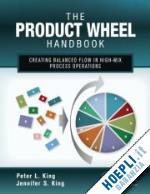Jennifer S. King is an operations research analyst with a government contractor, analyzing operational impacts of emerging Federal Aviation Administration (FAA) technologies and developing cost and performance models to support airline investment decisions. Prior to that, she spent 5 years with the Department of Defense developing discrete event simulation models to assist the army in setting reliability requirements for new platforms, and analyzing performance of weapon systems alternatives. Her prior publishing experience includes editing textbooks and developing mathematics problems and solutions for ExploreLearning.Jennifer has degrees in mathematics and psychology from the University of Virginia, and a master’s degree in operations research from the University of Delaware. She is a member of INFORMS.Peter L. King is the president of Lean Dynamics, LLC, a manufacturing improvement consulting firm located in Newark, Delaware. Prior to founding Lean Dynamics, Pete spent 42 years with the DuPont™ Company in a variety of control systems, manufacturing systems engineering, continuous flow manufacturing, and Lean manufacturing assignments. That included 18 years applying Lean manufacturing techniques to a wide variety of products, including sheet goods such as DuPont Tyvek®, Sontara®, and Mylar®; fibers such as nylon, Dacron®, Lycra®, and Kevlar®; automotive paints; performance lubricants; bulk chemicals; adhesives; electronic circuit board substrates; and biological materials used in human surgery. On behalf of DuPont, he consulted with key customers in the processed food and carpet industries. He retired from DuPont in 2007, leaving a position as principal consultant in the Lean Center of Competency. Recent clients have included producers of sheet goods, lubricants and fuel additives, and polyethylene and polypropylene pellets.Pete received a bachelor’s degree in electrical engineering from Virginia Tech, graduating with honors. He is Six Sigma Green Belt certified (DuPont, 2001), Lean manufacturing certified (University of Michigan, 2002), and a Certified Supply Chain Professional (APICS, 2010). He is a member of the Association for Manufacturing Excellence, APICS, and the Institute of Industrial Engineers where he served as president of IIE’s Process Industry Division in 2009–2010.Pete is the author of Lean for the Process Industries—Dealing with Complexity (Productivity Press, 2009), and several published articles on the application of Lean concepts to process operations. He has been an invited speaker at several professional conferences and meetings.DuPont™ Tyvek®, Sontara®, and Kevlar® are trademarks or registered trademarks of E.I. DuPont de Nemours and Company. Mylar® is a trademark of DuPont Teijin Films; Dacron® and Lycra® are trademarks of Koch.











